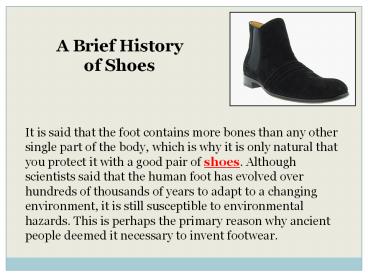A Brief History of Shoes | custom shoes - PowerPoint PPT Presentation
1 / 6
Title:
A Brief History of Shoes | custom shoes
Description:
www.veinwear.com - It is said that the foot contains more bones than any other single part of the body, which is why it is only natural that you protect it with a good pair of shoes. – PowerPoint PPT presentation
Number of Views:3763
Title: A Brief History of Shoes | custom shoes
1
A Brief History of Shoes
It is said that the foot contains more bones than
any other single part of the body, which is why
it is only natural that you protect it with a
good pair of shoes. Although scientists said that
the human foot has evolved over hundreds of
thousands of years to adapt to a changing
environment, it is still susceptible to
environmental hazards. This is perhaps the
primary reason why ancient people deemed it
necessary to invent footwear.
2
Speaking of invention, men were said to have
created footwear in 8,000 to 7,000 BC. Although
they look nothing like the custom shoes or the
complicated kicks worn by many nowadays,
this ancient sandal-like footwear was able to
serve the purpose of protecting the human foot
from extreme weather conditions, spiky and jagged
rocks, and sharp pointed objects left lying
around by one's "cave-mates."
3
Because it would take man another thousands of
years before he could invent plastics and
synthetic materials, ancient people used supplies
that are easily accessible to them to create
shoes. The oldest leather shoe found in Armenia
was made from you guessed it right leather,
which is made by tanning animal skin and hide.
Otzi the Iceman's footwear, which is said to be
first worn in 3,300 BC, featured brown bearskin
bases, deerskin side panels, and a bark-string
net.
4
As countries, particularly those in Europe,
gained in wealth and power, footwear has become a
status symbol for people. Artisans created
personalised men's shoes especially for rich male
patrons and people have learned to create new
styles and designs.
Toes became long and pointed and during the time
of the Renaissance, even men (including those
from the nobility) used footwear with high heels!
Can you imagine yourself, a full-blooded male
specie, wearing a shoe with a very high heel?
When in Rome...
5
Eventually, modern footwear, which features a
sewn-on sole, was born. During the 17th century,
most leather shoes had a sewn-on sole, which
remained in today's higher quality dress shoes.
Despite further development,
shoemakers of the old days made footwear without
differentiation from the left or right foot. So
if you were live during those times, you'd be
able to wear your right shoe for your left foot
and vice versa. Great for rotating the tires to
get even wear.
6
The use of traditional shoe crafting methods has
slowed down in the mid-20th century. Leather,
which has been used as primary material in
earlier styles,
is now mostly used in creating dress shoes since
most footwear are made from rubber, plastic, and
synthetic cloth. Soles, which were once
meticulously stitched on by hand, are now often
glued onto the vamp of a shoe.

